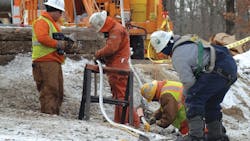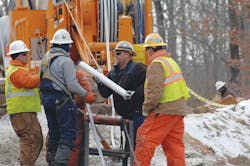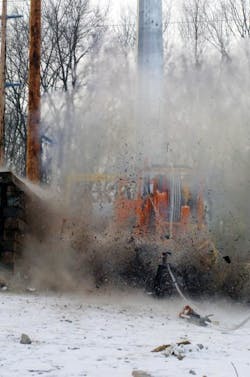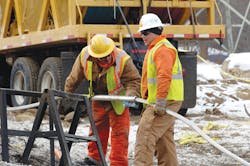Electric Grid Infrastructure Undergoes Modernization
To improve system reliability, electric utilities are upgrading infrastructure and replacing older assets. Connecticut Light & Power (CL&P) is no exception. In fact, Northeast Utilities, CL&P’s parent company, is planning to invest $3.7 billion over the next four years to construct, replace or upgrade older infrastructure in Connecticut, Massachusetts and New Hampshire. This initiative includes the construction of new high-voltage transmission lines and substations, or the upgrade of existing assets.
Currently, as part of CL&P’s 1990 Line Project, the utility is partnering with PAR Electrical Contractors Inc. to replace a row of older steel lattice transmission towers with new monopole structures in an existing 21-mile, 115-kV transmission right-of-way in the Waterbury, Connecticut, area.
Replacing Older Towers
The 1990 Line Project, which began construction in 2013 and is scheduled to be completed later this year, consists of two parts. The first, an 18-mile-long main section, runs south from the Frost Bridge Substation in Watertown, Connecticut, through Waterbury, Middlebury and Oxford, Connecticut, to the Stevenson Dam in Monroe, Connecticut. The second, a 3-mile-long section, runs east from Middlebury to the Baldwin Station in Waterbury.
The new monopole structures the utility is installing in these sections are engineered and designed to better withstand extreme weather conditions and meet today’s more stringent mandatory reliability standards. For example, current design standards for this region under the National Electrical Safety Code require that all transmission structures and lines be able to withstand hurricane-force winds of 110 mph as well as 1 inch of ice loading combined with 40-mph winds.
Installing Implosion Connectors
In addition, CL&P is using imploding connector technology, which is more electrically efficient and produces mechanically stronger connections than conventional methods like hydraulically pressed connectors. This saves time, reduces overall project costs, improves performance and provides better system reliability.
Each connector consists of an aluminum-alloy sleeve and a prewrapped energy charge or explosive. When detonated, most of the energy released in the implosion process is focused inward, which helps to create a more secure and efficient splice connection. For the 1990 Line Project, CL&P decided to use these connectors on mid-span splices over highways, rough terrain and wetland areas where environmental restrictions may make future access difficult or limited.
CL&P has hired a team of licensed professionals to store, transport and detonate these connectors. The connectors are detonated near the ground and in front of the conductor pulling and tensioning equipment to help decrease the noise produced by the detonation.
The PAR Electric construction team also stacks timber mats, which are normally used for wetland access, to help diminish the detonation sound, therefore lessening the effect on surrounding homes and businesses.
While the detonation lasts less than a second, the sound, which is similar to a loud clap of thunder or the final aerial burst of a commercial fireworks display, can be startling. Therefore, CL&P takes multiple measures to provide advanced warning to area customers, including homeowners, schools and first responders.
To educate the community about the process, which has been approved by federal and state officials, CL&P places newspaper ads, issues press releases, leaves letters in door hangers, and calls residents, schools and businesses within a mile radius of the work site to give them advanced notice.
CL&P also offers local newspaper and television reporters the opportunity to learn more in-depth information about the implosion process. As a result of this outreach campaign, the utility has not received any noise complaints since completion of the first phase of implosion work.
Pulling Sleeves Through Stringing Blocks
The terrain of the right-of-way includes residential areas, state parks, wetlands and major highway crossings. As such, it is not feasible to use the existing conductors as part of the process to pull the new conductor. PAR Electric uses a Winco Powerline Services helicopter to fly in the lead line ropes.
Next, the linemen use lead line ropes to pull the hard line from the pulling equipment. Since the conductor run was longer than the cable reel lengths, two reels had to be connected using a BURNDY IMPLO sleeve, which is designed to withstand the strain of being pulled through the stringing blocks. Thus far, this has been a successful operation, preventing crews from having to splice in wetlands and expediting the entire pulling process.
Coupled with work performed using the helicopter, the field workforce is able to perform the entire operation much more efficiently as opposed to employing a ground-based
operation.
This isn’t the first time CL&P has used imploding connectors. About seven years ago, the utility used this implosion technology to replace critical connectors on more than 100 miles of transmission lines in Connecticut and Massachusetts. The construction crews used this technology to replace hundreds of connectors that were installed more than 40 years ago.
Through these types of projects, CL&P is able to improve transmission system reliability for its customers. Using new technologies and techniques such as imploding connectors and stringing wires with a helicopter, CL&P is also able to expedite the process, save money and boost productivity in the field.
Jim Clark ([email protected]) is the project manager for the 1990 Line Project for Connecticut Light & Power. He has directed activities on the project since 2010 and is responsible for leading the effort from the planning phase through construction. Clark has worked in the utility industry since the mid-1980s.
Lance Clute ([email protected]) is the director of northeast operations for PAR Electrical Contractors Inc., which is assisting Connecticut Light & Power with the overhead transmission portion of the 1990 Line Project. Prior to joining PAR, Clute worked for another utility and is now based in Massachusetts. He began working in the utility industry in 1989.
Companies mentioned:
BURNDY | www.burndy.com
Connecticut Light & Power | www.cl-p.com
PAR Electrical Contractors Inc. | www.parelectric.com
Winco Powerline Services | www.wincoservices.com
Sidebar: Benefits of Imploding Connectors
1. Higher electric reliability is achieved because the process eliminates oxide growth as well as the introduction of moisture into the connection. Also, the new connections are designed to work at temperatures 40% lower than the conductor, eliminating the possibility of hot spots.
2. There is a more efficient flow of electricity through the lines.
3. Project completion time is faster because the implosion connectors do not require crews to set up and install equipment to connect the high-voltage conductors, as is the case with hydraulic compression.
4. Maintenance costs are reduced.
5. The conductors can be installed in environmentally sensitive areas because they can be pulled through stringing blocks through areas with limited access.
Sidebar: How the Implosion Process Works
1. Crews prepare transmission lines to install imploding connectors.
2. The highly specialized team then installs the implosion connectors. These connectors consist of a small, engineered energy charge, which is prewrapped around a specifically designed metallic sleeve.
3. The subsequent charge creates an implosive compression, which forms a permanent connection. During this process, it generates a flash and air blast similar to a commercial fireworks display.
Sidebar: Performing Proactive Vegetation Management
To improve reliability, Connecticut Light & Power is not only upgrading its aging infrastructure, but it is also performing proactive vegetation management on its system. Here are three ways the company is improving clearances and hardening the system:
1. The utility’s in-house arborists are inspecting and removing hazard trees outside the right-of-way. By identifying these trees, CL&P is able to prevent trees from falling into the transmission circuit.
2. CL&P is advancing its 10-year trimming cycle in the transmission corridor.
3. The utility is performing complete side trimming to establish the required distances between the transmission lines and the trees and branches outside the right-of-way.



